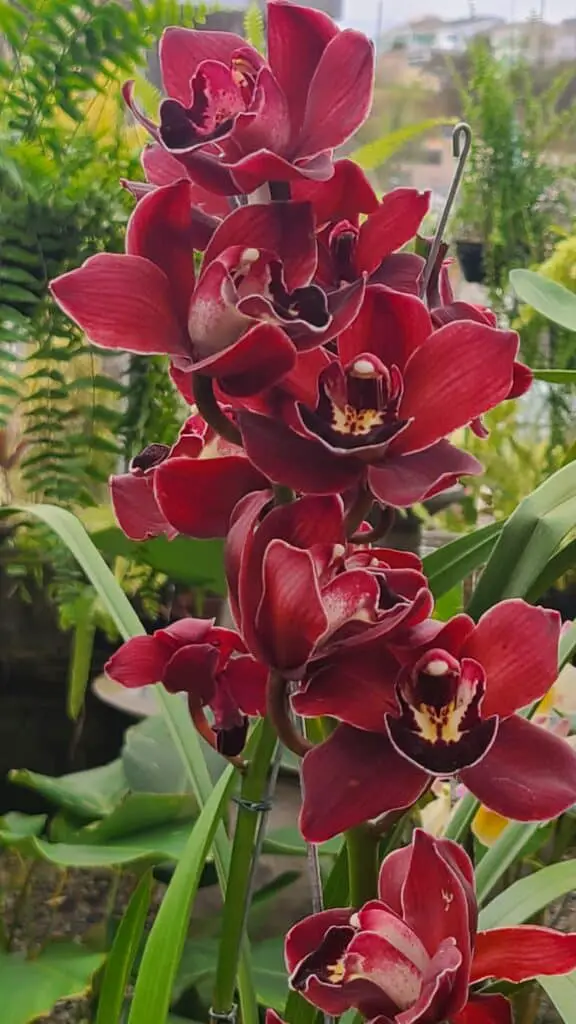Onion peels, often discarded as waste, actually contain a wealth of vitamins, minerals, amino acids, and other nutrients that can greatly benefit your garden. I found a myriad of studies showing the wide-variety of benefits of using onion skins, but when it comes specifically to orchid care, there wasn’t much to rely on.
So once more, I had to go find some information on my own and create this article. The main question I wanted answered was, “Will incorporating this natural and nutrient-rich infusion into your orchid care routine help promote their growth and overall health?“
The lack of precision in nutrient transfer, the risk of chemical imbalances and pathogen introduction, and the impact of boiling water on mineral-sensitive orchids are all factors to take into account that lead me to discard the onion peels method.
-Amanda Matthews
To reach my conclusion of whether or not onion peels actually helps the orchid grow, I first had to understand what the onion peel has in it and how it interacts with both humans and plants. Studies have shown that onion peels, including the top, skin, outer layers, and bottom sections, contain significant amounts of bioactive chemicals like cysteine sulfoxide, quercetin glucosides, and quercetin, with multiple therapeutic benefits. (Source)
One of the key components found in onion peels is cysteine sulfoxide, a sulfur-containing compound. This compound has antimicrobial, anti-inflammatory, and immunomodulatory properties. Sulfur is one of the macro-nutrients that orchids need and it is in all good brand-name orchid fertilizers. (Source)The sulfur dose in these commercially-sold fertilizers is usually about 0.05 to 0.09% of sulfur. Sulfur can help protect your plants from harmful pathogens and reduce inflammation in their tissues.
Additionally, onion peels contain phenolic components such as quercetin glucosides and quercetin, which also contribute to the health attributes of the peels. How much and to what extent are still to be studied, and on a deeper level, the water the the onion peel was soaked in, hasn’t been studied (at least I couldn’t find it).
As far as human benefits, the bioactive compounds in onion peels have the potential to be used in the development of food supplements or functional foods for the treatment and prevention of various conditions. These conditions include nephropathy, obesity, cancer, neurodegenerative diseases, diabetes, cardiovascular disease, and respiratory disorders. Yeah… I get it… But this is all wonderful for us humans, but what about plants? Back to the books…
I found so much information about utilizing onion peels in horticulture, that you can tap into their hidden potential and enhance the well-being of your garden, but the emphasis was always on garden… with soil. I guess the terrestrial orchids (Nervilia, Eulophia, Pachystoma, Phaius, Liparis, Acanthephippium, Erythodes, Macodes, Hetaria and Zeuxine are a few examples but terrestrial orchids include over 200 genera) would benefit from water infused with onion peels.
Instead of throwing away these nutrient-rich peels as garbage, consider using them to create a water infusion or compost them to enrich the soil. The vitamins, minerals, amino acids, and other nutrients present in onion peels can contribute to the growth and vitality of your plants, leading to healthier and more productive gardens.
But… Do onions peels actually help epiphyte orchids? Orchid care is a whole different ball game and in this article, I want to go over the reasons why I won’t use onions to water my orchids and the why behind that.

Image Credit: Orchideria.com
How Orchids take in their Nutrients
Orchids are unique plants with specialized roots that differ from those of normal houseplants. While most orchids are epiphytes, meaning they grow on other plants or objects, it is important to understand how they take in nutrients. Unlike typical houseplant roots that absorb nutrients from the soil, orchid roots have adapted to obtain nutrients from the air and water. Orchids, like other plants, primarily absorb nutrients that are dissolved in water, provided in the form of water-soluble fertilizers, which are easily taken up by the plant’s roots. So nutrients that orchids receive need to be water-soluble for the orchid to atucally “drink” them.
Since nothing in orchid care is 100% for everything, I would like to note that orchids can also absorb some nutrients that are not water-soluble (to a certain extent). This usually happens when these nutrients are present in the growing medium and come into direct contact with the plant’s roots. Over time, these nutrients can be slowly absorbed by the plant. That’s where the controversial topic of eggshells come in. If you want to read more about eggshells, I wrote this article that might help.
It’s important to note that the ability of orchids to absorb non-water-soluble nutrients can vary depending on the specific nutrient, the orchid species, and the growing conditions. Therefore, it’s generally recommended to provide orchids with a balanced, water-soluble fertilizer that contains all necessary macro and micronutrients. The easiest way to do this is with fertilizers specifically made for orchids.
You may be asking, “But how do the orchids take in these nutrients?” Orchid roots have a velamen layer, which is a spongy tissue that surrounds the root. This velamen layer, aside from clinging to tree bark, acts as a sponge, absorbing moisture and nutrients from the surrounding environment.
Orchids are highly sensitive to mineral content, and excessive amounts of minerals can actually harm them. So even if the onion-infused water has a lot of sulfur, please don’t over-water your orchid with this solution. Also, there is no way of knowing how much sulfur is actually present in this onion water unless you test every single infusion. Therefore, it is crucial to provide orchids with a balanced and diluted fertilizer solution. It’s always best to apply too little fertilizer than too much.

Image Credit: orchideria.com
Cons of Onion Water in your Orchid
Using water infused with soaked onion peels on your household plants, especially orchids, have some drawbacks. While boiling onion skins in water may extract some nutrients, it is important to note that not all the nutrients listed in an onion peel will be 100% transferred to the water. The infusion process is not precise, and there is no way of knowing how much or which nutrients will be infused into the water and at what rate. It is also worth mentioning that not all onions are created equal in terms of nutrient content.
To put it differently, the chemicals that end up in the water after steeping an intact onion skin are not the same as the chemicals that result from the decay of plant matter. Decay involves multiple chemical reactions and physical processes, including the mechanical and chemical digestion of critters, bacteria, fungi, and more. Commercial fertilizers, on the other hand, are often tested for bioavailability to plants and measured for specific mineral and chemical content. The lack of testing and measurement for onion water may raise concerns about its effectiveness as a nutrient source for orchids.
Another potential drawback of using onion water on orchids is the risk of causing chemical or pH imbalances in the growing medium. The introduction of onion water may alter the pH levels, which can negatively impact the orchid’s ability to absorb nutrients. Additionally, the infusion may attract pests and introduce pathogens such as bacteria or fungi that were hiding in the onion peels. This can create an environment that is more detrimental to the orchid and more friendly to pathogens than the original state.
Furthermore, boiling water by itself can have its own impacts on mineral-sensitive epiphytic orchids. Boiling water reduces the available dissolved oxygen and increases the parts per million (ppm) mineral content. These changes in water composition can potentially affect the orchid’s ability to absorb nutrients and may have unintended consequences on its overall health.
In conclusion, while using onion water as a fertilizer for orchids may seem like a natural and cost-effective option, it is important to consider the potential drawbacks. The lack of precision in nutrient transfer, the risk of chemical imbalances and pathogen introduction, and the impact of boiling water on mineral-sensitive orchids are all factors to take into account. It is advisable to explore alternative fertilization methods that are specifically formulated for orchids to ensure optimal growth and health.
Water Infusion with Onion Skin Recipe Instructions
If you have already decided to use onion peels soaked in water to help aid your orchid, and whatever I say isn’t really going to make a difference, here is the recipe. I have seen people use this method and they swear that it works. I continue to maintain my opinion about onion-water, but each growing method is unique. To make a water infusion with leftover onion skins, follow these simple steps:
1. Gather the onion skins: Collect a handful of onion skins from the onions you have used in your cooking. Make sure to remove any dirt or debris from the skins.
2. Prepare a pot of water: Fill a pot with approximately 1 liter (33.8 ounces) of water. This amount can be adjusted depending on the number of onion skins you have.
3. Add the onion skins to the water: Place the onion skins into the pot of water. Ensure that the water covers the skins completely.
4. Bring the water to a boil: Put the pot on the stove and bring the water to a boil. Allow it to boil for about 5 minutes to extract the beneficial compounds from the onion skins.
5. Simmer the mixture: Reduce the heat to low and let the water and onion skins simmer for another 15-20 minutes. This will further infuse the water with the nutrients and bioactive compounds from the onion skins.
6. Strain the infusion: After simmering, remove the pot from the heat and strain the water to separate the onion skins from the infusion. You can use a fine-mesh strainer or cheesecloth for this purpose.
7. Let it cool: Allow the onion skin infusion to cool down to room temperature before using it on your orchids. This will prevent any potential damage to the plants from hot water.
Now, you have a homemade water infusion made from onion skins that can be used to water your orchids. Remember to store the infusion in a clean, airtight container and use it within a few days for the best results. Orchids only need a little of whatever fertilizer you are applying, so don’t go overboard with this infusion. A badly cared for orchid will take time to grow back into health.
Don’t Stop Learning!
If you want to be included in more information and get a 14-page fertilization guide, please sign up for my newsletter. I don’t spam, but send emails out bi-monthly with some curious topics of interest. If you want more information, click here to go to a specific page on this website where I explain it more in detail.

Also, if you are looking for an orchid journal to keep your notes specifically about orchid care, check out my 2 solutions for that on this page. If note-keeping isn’t your thing, then there is a free excel spreadsheet that you can download. Click here for more information on how to do that.
If you subscribe to my newsletter, I will send you a 14-page guide on the main tips of orchid fertilizer. It is downloadable and you can print it out on your computer. I designed the guide to double up as a coloring book, just to make it fun.
In all, I hope this article helped you. Please reach out if you have anything to add or if it was unclear. Thanks for reading and happy cultivating!

